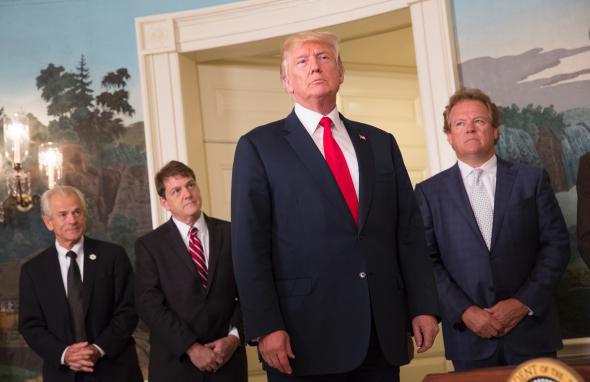On Saturday, the president of the United States condemned the violence “on many sides” in Charlottesville, Virginia, as white supremacists literally marched through the streets and killed an opposing protester. On Sunday, sensing that people weren’t particularly happy with his relativism on the deadly incident, White House spokespeople fanned out on the Sunday talk shows to sharpen the president’s tepid response. The White House also released an anonymously sourced statement, at last, specifically naming white supremacist hate groups as an actual, explicit problem. “The President said very strongly in his statement yesterday that he condemns all forms of violence, bigotry, and hatred. Of course that includes white supremacists, KKK, neo-Nazi and all extremist groups,” the statement read. Yes, of course.
With the president’s response still lacking, and far-right white nationalist groups declaring Trump’s noncondemnation condemnation a victory, the White House hastily scheduled a press conference Monday to try to get it right on the third try. The only thing is: Trump didn’t want to. He thought he had already nailed it the first time. That’s according to the Associated Press, which spoke to aides about the president’s meandering response.
Loath to appear to be admitting a mistake, Trump was reluctant to adjust his remarks. The president had indicated to advisers before his initial statement Saturday that he wanted to stress a need for law and order, which he did. He later expressed anger to those close to him about what he perceived as the media’s unfair assessment of his remarks, believing he had effectively denounced all forms of bigotry, according to outside advisers and White House officials.
Several of Trump’s senior advisers, including new chief of staff John Kelly, had urged him to make a more specific condemnation, warning that the negative story would not go away and that the rising tide of criticism from fellow Republicans on Capitol Hill could endanger his legislative agenda, according to two White House officials.
So let’s be clear: The president of the United States didn’t want or believe he needed to make his second statement actually condemning white supremacists Monday. From the AP’s version of events, Donald Trump does not see what he did wrong the first time and one of the ways his chief of staff tried to convince him to denounce the KKK was to make clear to him that going soft on unbridled bigotry was bad politically for him. Kelly played to the president’s profound selfishness in reminding Trump that he personally would lose something—his “agenda” (whatever that is)—if he didn’t do more to condemn the historical and ongoing scourge of white supremacist violence and intimidation.
After all of that, the president of the United States sauntered up to the podium at the White House on Monday and ticked off his administration’s so-called accomplishments on the economy, trade, and job creation. “As I said on Saturday,” Trump said, still dragging his feet, as he got around to Charlottesville again. “Racism is evil,” Trump said. “And those who cause violence in its name are criminals and thugs, including the KKK, neo-Nazis, white supremacists and other hate groups that are repugnant to everything we hold dear as Americans.”
Now, one more time—like you mean it.
